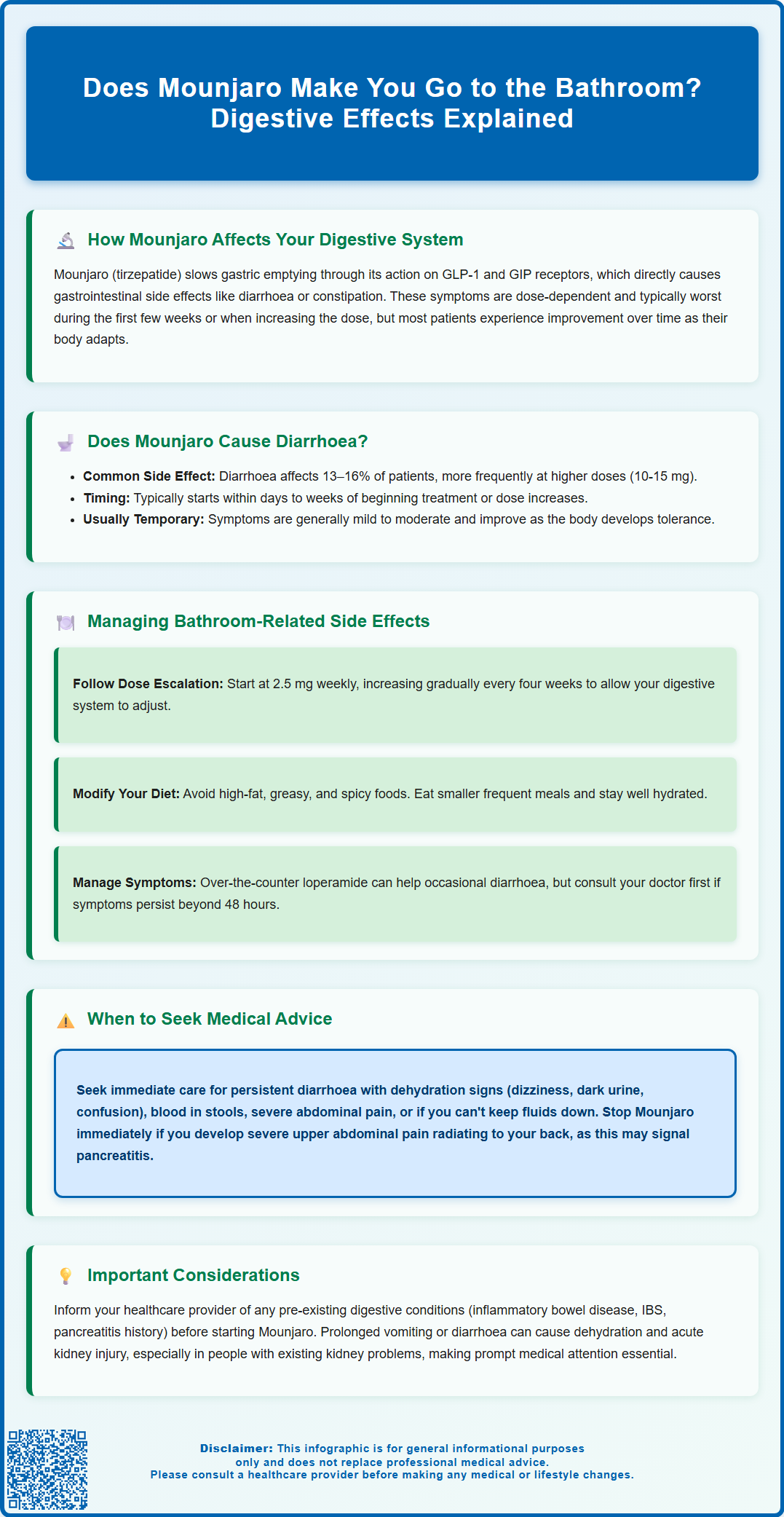Mounjaro®
Dual-agonist support that helps curb appetite, hunger, and cravings to drive substantial, sustained weight loss.
- ~22.5% average body weight loss
- Significant weight reduction
- Improves blood sugar levels
- Clinically proven weight loss

Mounjaro (tirzepatide) is a dual GIP and GLP-1 receptor agonist licensed in the UK for type 2 diabetes mellitus. Many patients wonder whether Mounjaro affects bowel habits. Gastrointestinal side effects, including diarrhoea and altered bowel patterns, are among the most commonly reported effects of this medication. These symptoms result from tirzepatide's action on gut motility and gastric emptying—key mechanisms that help regulate blood glucose and appetite. Understanding why these effects occur, how to manage them, and when to seek medical advice can help patients use Mounjaro safely and effectively whilst minimising disruption to daily life.
Summary: Mounjaro (tirzepatide) commonly causes gastrointestinal side effects including diarrhoea and altered bowel patterns in approximately 13–16% of patients, resulting from its action on gut motility and gastric emptying.
Mounjaro (tirzepatide) is a dual glucose-dependent insulinotropic polypeptide (GIP) and glucagon-like peptide-1 (GLP-1) receptor agonist licensed in the UK for the treatment of type 2 diabetes mellitus. Understanding its mechanism of action helps explain why gastrointestinal effects, including changes in bowel habits, are among the most commonly reported side effects.
Tirzepatide works by mimicking naturally occurring incretin hormones that regulate blood glucose levels and appetite. These hormones slow gastric emptying—the rate at which food moves from the stomach into the small intestine—which contributes to improved glycaemic control and increased satiety. This slowing of gastric emptying can influence digestive processes, leading to various gastrointestinal symptoms.
The medication's effect on gut motility means that some patients experience altered bowel patterns, which may manifest as either diarrhoea or, less commonly, constipation. Clinical trial data demonstrates that gastrointestinal adverse effects are dose-dependent and typically most pronounced during the initial weeks of treatment or following dose escalation. The SURPASS clinical trial programme showed that nausea, diarrhoea, and other digestive symptoms were reported by a significant proportion of participants, though most cases were mild to moderate in severity.
It is important to recognise that these effects result from the drug's intended pharmacological action on the digestive system rather than representing an allergic reaction or intolerance. The gastrointestinal tract contains numerous GLP-1 and GIP receptors, making it particularly responsive to tirzepatide. Most patients find that digestive symptoms improve over time as the body adapts to the medication, though the timeframe varies between individuals.
Importantly, prolonged vomiting or diarrhoea can lead to dehydration and may worsen kidney function. If you are unable to maintain adequate fluid intake due to digestive symptoms, seek medical advice promptly.

Diarrhoea is one of the most frequently reported side effects of Mounjaro, affecting approximately 13–16% of patients in clinical trials, depending on the dose administered. The incidence tends to increase with higher doses, with the 10 mg and 15 mg strengths associated with slightly higher rates compared to lower doses. However, it is worth noting that the majority of patients do not experience significant diarrhoea, and when it does occur, it is usually transient.
The exact mechanism for diarrhoea with Mounjaro is not fully understood. Tirzepatide's effects on GLP-1 receptors slow gastric emptying and can alter gastrointestinal motility and secretion, which may result in changes to bowel habits. These complex effects on the digestive system can lead to either diarrhoea or constipation in different individuals.
Characteristics of Mounjaro-related diarrhoea typically include:
Onset within days to weeks of starting treatment or increasing the dose
Mild to moderate severity in most cases
Gradual improvement over several weeks as tolerance develops, though this varies between individuals
Absence of blood, severe abdominal pain, or fever (which would suggest alternative causes)
Some patients report increased frequency of bowel movements without frank diarrhoea—simply needing to use the bathroom more often than usual. This can be related to dietary changes that often accompany Mounjaro treatment, as patients may increase their fibre intake or alter their eating patterns in response to appetite changes. The distinction between medication effect and dietary influence can sometimes be difficult to determine, but both factors may contribute to changes in bowel habits during Mounjaro therapy.
Persistent watery diarrhoea poses a risk of dehydration and potential kidney injury, particularly in older adults or those with existing kidney problems. If diarrhoea is severe or persistent, contact your healthcare provider.
Practical strategies can significantly reduce the impact of digestive side effects while taking Mounjaro. The MHRA-approved prescribing information emphasises the importance of gradual dose escalation, which allows the gastrointestinal system time to adapt to the medication. The standard titration schedule begins with 2.5 mg once weekly for four weeks (this is an initiation dose only, not intended for glycaemic control), increasing by 2.5 mg increments every four weeks as tolerated.
Dietary modifications can be particularly helpful in managing bowel-related symptoms:
Avoid high-fat, greasy, or spicy foods, which can exacerbate diarrhoea and nausea
Eat smaller, more frequent meals rather than large portions, which may overwhelm the slowed digestive system
Stay well hydrated with regular fluid intake throughout the day (if you have heart or kidney disease and are on fluid restriction, follow your clinician's specific advice)
Limit caffeine and alcohol, which can stimulate the bowel and worsen diarrhoea
Maintain adequate fibre intake from sources like oats, bananas, and rice, which can help regulate bowel consistency
For patients experiencing diarrhoea, over-the-counter loperamide may provide symptomatic relief for occasional use, though this should be discussed with your GP or prescribing clinician first. Do not use loperamide if you have bloody stools, high fever, or significant abdominal pain, and seek medical advice if diarrhoea persists beyond 48 hours. It is important not to mask symptoms that might indicate a more serious condition.
Timing considerations can also help: taking Mounjaro on the same day each week allows patients to manage their schedules around potential symptoms, which often occur after starting or increasing the dose, though timing varies between individuals. If side effects remain troublesome despite these measures, discuss with your prescriber whether temporarily maintaining your current dose for an additional four weeks before escalating might be appropriate.
If you experience side effects from Mounjaro, consider reporting them through the MHRA Yellow Card scheme (yellowcard.mhra.gov.uk).
While mild gastrointestinal symptoms are expected with Mounjaro, certain features warrant prompt medical assessment. It is essential to distinguish between common, self-limiting side effects and symptoms that may indicate complications or alternative diagnoses requiring investigation.
Contact your healthcare provider promptly if you experience:
Persistent diarrhoea with signs of dehydration, including dizziness, reduced urine output, dark urine, dry mouth, or confusion
Inability to keep fluids down due to vomiting or diarrhoea
Blood or black, tarry stools, which may indicate gastrointestinal bleeding
Severe or worsening abdominal pain, particularly if constant or localised to the upper abdomen
Right upper abdominal pain, fever or yellowing of the skin/eyes, which could indicate gallbladder problems (cholelithiasis or cholecystitis)
Persistent vomiting preventing adequate fluid or medication intake
Fever accompanying diarrhoea, suggesting possible infection
Unintentional weight loss exceeding expected therapeutic effects or signs of malnutrition
According to NICE guidance on diabetes management, patients should have regular review appointments when taking GLP-1 receptor agonists. These provide opportunities to discuss tolerability and adjust treatment if needed. If gastrointestinal symptoms significantly impair quality of life or prevent dose escalation to therapeutically effective levels, your clinician may consider alternative management strategies.
Important safety considerations include:
If pancreatitis is suspected (severe, persistent upper abdominal pain often radiating to the back, with nausea/vomiting), tirzepatide should be discontinued immediately and not restarted if pancreatitis is confirmed
Mounjaro is not recommended for patients with severe gastrointestinal disease, including severe gastroparesis (delayed gastric emptying)
Prolonged vomiting or diarrhoea can lead to dehydration and acute kidney injury, particularly in those with pre-existing kidney problems
For patients with pre-existing gastrointestinal conditions such as inflammatory bowel disease, irritable bowel syndrome, or a history of pancreatitis, closer monitoring may be appropriate. There is no official contraindication for most digestive conditions, but individual risk-benefit assessment is important. Always inform your healthcare provider of your complete medical history before starting Mounjaro to ensure safe and appropriate use of this medication.
Diarrhoea affects approximately 13–16% of patients taking Mounjaro, with incidence increasing at higher doses. Most cases are mild to moderate and improve over several weeks as the body adapts to the medication.
Mounjaro slows gastric emptying and affects gut motility through its action on GLP-1 and GIP receptors in the gastrointestinal tract. These are intended pharmacological effects that help regulate blood glucose and appetite but can lead to altered bowel patterns.
Seek medical advice promptly if you experience persistent diarrhoea with signs of dehydration, bloody or black stools, severe abdominal pain, persistent vomiting, fever, or inability to maintain adequate fluid intake.
The health-related content published on this site is based on credible scientific sources and is periodically reviewed to ensure accuracy and relevance. Although we aim to reflect the most current medical knowledge, the material is meant for general education and awareness only.
The information on this site is not a substitute for professional medical advice. For any health concerns, please speak with a qualified medical professional. By using this information, you acknowledge responsibility for any decisions made and understand we are not liable for any consequences that may result.
Lorem ipsum dolor sit amet, consectetur adipiscing elit, sed do eiusmod tempor incididunt ut labore et dolore magna aliqua. Ut enim ad minim veniam, quis nostrud exercitation ullamco laboris nisi ut aliquip ex ea commodo consequat. Duis aute irure dolor in reprehenderit in voluptate velit esse cillum dolore eu fugiat nulla pariatur.
Block quote
Ordered list
Unordered list
Bold text
Emphasis
Superscript
Subscript